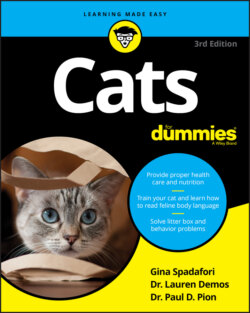Читать книгу Cats For Dummies - Gina Spadafori - Страница 24
She-Kitty, He-Kitty: Which One’s Better?
ОглавлениеYou’re not going to get a definitive answer out of us on this one, even if we had one, which we don’t. Males and females make equally good pets, under one very important condition: altering.
Male or female, a cat who is what the experts call whole or intact — in other words, fully equipped to reproduce — is a royal pain to live with. When females are “in season” — which happens several times a year, for a couple weeks at a time — they’re yowly escape artists who attract noisy suitors from miles around, and engage in very noisy mating rituals with the neighborhood toms. By the time an intact cat is sexually mature, many begin spraying — marking territory with a special pheromone-spiked urine with a smell that’s not only foul but also nearly impossible to eradicate. They’re also roamers and fighters. While some altered cats exhibit these behaviors, they’re far more common in cats who have not been spayed or neutered.
Altering goes a long way toward eliminating spraying, but more is involved in curing this disagreeable behavior. For the lowdown on this smelly problem, see Chapter 11. What’s involved in altering — commonly known as spaying or neutering — a cat? The answer’s in Chapter 13.
The experts — even reputable breeders who keep intact cats for their breeding programs — all agree that neutering is the key to a cat being a good pet, no matter the gender. An important contribution that those involved in the sport of showing cats have made is to ensure that animals who can no longer breed can still compete — in classes for alters. This aspect of showing is wonderfully progressive and supportive of those who like to show their lovely cats but not breed them.
After cats are altered, is one gender then a better pet than the other? The answer depends on whom you ask. Some people believe males are a little more outgoing; others suggest that females are smarter. Still others think that color or markings matter more and that, for example, variations of the genetic dice roll that produce orange cats — tabbies, calicos and tortoiseshells — also create a cat who seems a little more crazy than others. Others think these cats are super affectionate and playful. As we said, it depends on whom you ask.
Perhaps the biggest reason some people prefer one gender over another we can sum up by using the word always — they have always had males (or females), have always been happy with their choices, and see no reason to change.
If you’re thinking about adopting a pedigreed kitten, you may not have a choice about the gender: Males may be all that the breeder is offering for sale, especially if the breed is rare or in development. That’s because the females are held back to remain part of the breeding stock or shared only with those the breeder believes are willing to show and breed the kitten as she recommends.
Both male and female cats make good pets, and we can’t really steer you in one way or another. If you have a personal preference, go with it. If not, make all your other decisions and then go with the kitten that best fits your criteria, male or female.
